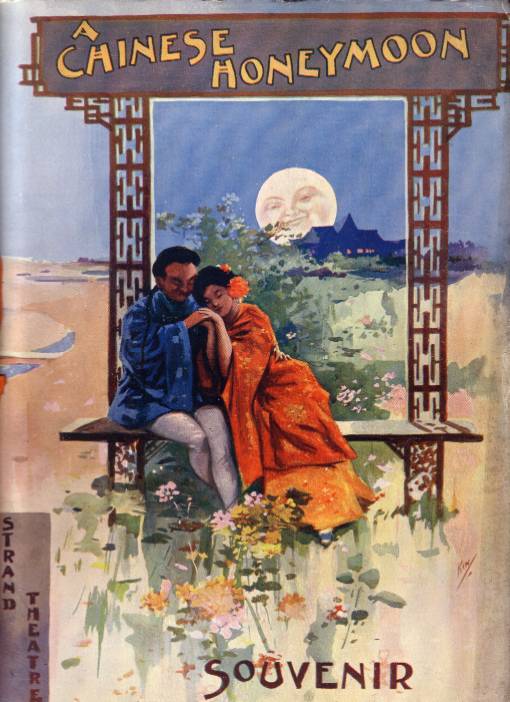- Royal Strand Theatre
Infobox Theatre
name = Royal Strand Theatre
image_size = 200px
caption = 2nd Anniversary Souvenir from "A Chinese Honeymoon " (1903)
address = Strand, Westminster
city =London
country =
designation = "Demolished"
latitude = 51.513056
longitude = -0.1175
architect = Charles Broad
owner = Benjamin Lionel Rayner
capacity = c. 1500
type =
opened =15 January 1832
yearsactive = 1832–1904
rebuilt = 1836 unknown
1858 S. Reynolds and Samuel Field
1865 John Ellis
1882Charles J. Phipps
closed =
othernames = Barker's Panorama
Rayner's New Subscription Theatre
The New Strand (Subscription) Theatre
Punch's' Playhouse and Marionette Theatre
production =
currentuse = Site occupied by station
website = :"Aldwych was also home to the later Strand Theatre"The Royal Strand Theatre was located in the Strand in theCity of Westminster . The theatre was built on the site of apanorama in 1832, and in 1882 was rebuilt by the prolific theatrearchitect Charles J. Phipps . It was demolished in 1905 to make way forAldwych tube station .History
From 1801, Thomas Edward Barker set up a rival
panorama to his father's inLeicester Square , at 168/9 Strand. On the death of Robert Barker, in 1806, the two panoramas were run jointly until 1830. Their building was then used as adissenting chapel and was purchased by Benjamin Lionel Rayner, a noted actor in 1832."From Stage to Platform: The Metamorphosis of the Strand Theatre 1830–1905", Paul Hadley (London Passenger Transport 1984 No. 12 April, pp. 588-593)]Raynor engaged Charles Broad to convert and extend the original building as a theatre. This was built in 1832 in 7 weeks, at a cost of £3,000. The theatre opened on
15 January 1832 , as "Rayner's New Subscription Theatre", with a production of "Struggles at Starting". Within weeks, the venture failed and was sold to the actress Harriet Waylett, re-opening as "The New Strand (Subscription) Theatre". Again, the theatre lacked support and closed in November 1832. The theatre was re-opened in early 1833 as the " New Strand Theatre", by Fanny Kelly – who also based a drama school there. The theatre failed because it was unlicensed, and this put it into competition with London'spatent theatre s. Presenting plays by subscription was one method of evading the Acts, but tickets could not be sold at the theatre. This was circumvented by selling them at neighbouring shops; and at one point the public were admitted free on purchase of an ounce of rose lozenges for four shillings (stalls), or half an ounce of peppermint drops for two shillings (the pit) from the neighbouring confectioners.The theatre was again closed under the Patent Acts in March 1835, and the owners brought before the magistrates. It reopened on
25 April 1836 , with the necessary licence, under the management ofDouglas William Jerrold and James Hammond. The theatre was enlarged in 1836 and a gallery added in 1839. The theatre became the "Strand Theatre" in 1850, and for a while in 1851 was owned byWilliam Robert Copeland , and known as "Punch's' Playhouse and Marionette Theatre". In 1858, the theatre was taken over by William Swanborough and rebuilt at a cost of £7000, opening on5 April 1858 as the "Royal Strand Theatre".The theatre now began to enjoy some success with Ada Swanborough, performing in
H. J. Byron 'sburletta s featuring a cast that included James Thorne,Edward O'Connor Terry , Miss Raynham, Mrs. Raymond, andMarie Wilton , and the series continuing until 1872. [ [http://www.arthurlloyd.co.uk/RoyalStrand.htm "Royal Strand Theatre, Aldwych"] (Arthur Lloyd Theatre history) accessed 9 July 2008] The theatre was rebuilt in 1865, re-opening 18 November 1865, destroyed by fire on 21 October 1866 and rebuilt. The theatre featured the first appearance of the popularpantomime character,Widow Twankey played by James Rogers, in "Alladin " in 1861. It was also home to many successful burlesques, operettas and other works in the 1870s, including "Madame Favart " and "Olivette".The theatre was condemned as having inadequate fire precautions and closed 29 July 1882; rebuilt by
Charles J. Phipps , re-opening 18 November 1882 – with improved access. Attempts were made to recoup the expenditure through a sale, but this was unsuccessful. The musical comedy "A Chinese Honeymoon " opened in October 1901 and ran at the theatre for a record breaking 1,075 performances, until closing in 1904.Demolition
In the 16th century, the Strand had hosted many grand houses, by the
River Thames and the area began to be built up. By the end the 18th, it had become a notorious rookery - an overcrowded slum. The area had been unaffected byGreat Fire of London and survived with narrow streets, unsuited to the new traffic. A scheme was instituted to build a new road,Kingsway betweenHolborn and the Strand, culminating in a grand crescent,Aldwych . After many false starts, the scheme was begun in 1901 by theLondon County Council . To go with this a link was built to the tube station at Holborn, and in 1905 the theatre was acquired by Act of Parliament and demolished to enable Aldwych underground station to be constructed on the site. The station is now closed but is said to be haunted be an actress who still scares people today.Apart from this theatre, the Olympic,
Opera Comique ,Globe Theatre (Newcastle Street) , Old Gaiety and many others were swept away by the scheme, they were replaced by the Gaiety, Aldwych and New Theatres, and a realignment of the Lyceum.References
*"Guide to British Theatres 1750-1950", John Earl and Michael Sell pp. 250 (Theatres Trust, 2000) ISBN 0-7136-5688-3
External links
* [http://www.arthurlloyd.co.uk/RoyalStrand.htm "Royal Strand Theatre, Aldwych"] (Arthur Lloyd Theatre history)
* [http://library.kent.ac.uk/library/special/icons/playbills/londonstrand.htm "New Strand Theatre, Westminster"] (Templeman Library),University of Kent
Wikimedia Foundation. 2010.
